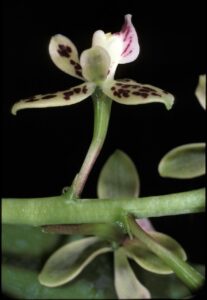Prosthechea vespa

Unmasking the Mystery: Propagating the Exotic Prosthechea vespa Orchid
The world of orchids is filled with captivating shapes and vibrant colors, and the Prosthechea vespa, aptly nicknamed the "Vespa Orchid" for its resemblance to a wasp in flight, is no exception. This unique orchid, native to Central and South America, enchants with its intricate blooms and sweet fragrance. But if you’re lucky enough to have one gracing your home, you might wonder, "How can I propagate this beauty and share its splendor?" While not for the faint of heart, propagating the Prosthechea vespa, though challenging, is a rewarding endeavor for dedicated orchid enthusiasts.
Understanding the Basics:
Before diving into techniques, it’s essential to understand how this orchid grows. Prosthechea vespa is an epiphyte, meaning it naturally grows on other plants, typically trees, for support. They are sympodial orchids, meaning they grow laterally from a rhizome and produce pseudobulbs, which store water and nutrients.
- Division:
This is the most common and often most successful method.
- Timing is Key: Divide your Prosthechea vespa during its active growth phase, typically in spring or early summer. Look for signs like new roots emerging from the base of the pseudobulbs.
- Dividing with Care: Gently remove the orchid from its pot and carefully separate the rhizome, ensuring each division has at least 3-4 healthy pseudobulbs and a strong root system. Sterilize your cutting tools with rubbing alcohol between cuts to prevent disease transmission.
- Potting Your Divisions: Plant each division in a well-draining orchid mix, ensuring the base of the pseudobulbs is level with the potting medium.
- Backbulbs:
Backbulbs are older, leafless pseudobulbs that can potentially sprout new growths.
- Stimulating Growth: Remove any dry sheaths from the backbulb. You can then place it on top of moist sphagnum moss or a specialized orchid mix formulated for seedlings.
- Patience is a Virtue: Keep the environment humid and warm (around 70-80°F), providing bright, indirect light. It might take several months for backbulbs to sprout new growths.
Essential Care for Success:
- Light: Prosthechea vespa thrives in bright, indirect light. Avoid direct sunlight, as it can scorch its leaves.
- Water: Water thoroughly when the potting mix approaches dryness. Good air circulation is crucial to prevent fungal issues, so ensure your orchid has adequate ventilation.
- Humidity: Aim for humidity levels between 50-70%. You can increase humidity by using a humidifier, placing the pot on a pebble tray filled with water, or grouping plants together.
- Fertilizer: Feed your orchids regularly during the growing season (spring and summer) with a balanced, diluted orchid fertilizer.
Propagating the Prosthechea vespa requires patience, observation, and the right conditions. Still, seeing new growth emerge from your efforts is incredibly rewarding. By understanding this orchid’s needs and utilizing the proper techniques, you can increase your chances of success and share the captivating beauty of the "Vespa Orchid" with fellow enthusiasts.